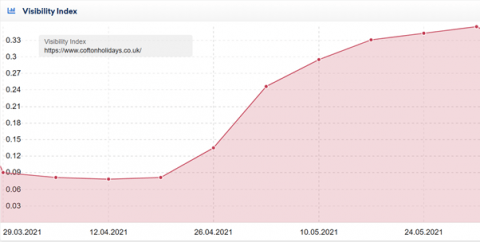What will you find in June’s edition?
SEO
Core Web Vitals Update
SEO Recommendation Implementation Rates
Google’s Indexing Still Not 100% Mobile
Paid Media
Enhanced Shopping Integrations
Google Announces Travel Product Updates
Privacy-Focused Changes Have Been Announced For Analytics, Tag Manager and Enhanced Conversions
Content Marketing
New Content to Get Stuck Into
NEW – Your 18-Step Guide to Paid Social Advertising Funnels
Getting Creative & Client Wins: Cofton Holidays and Ancasta
Let’s start with SEO…
Core Web Vitals Update
May was meant to be the month where the Core Web Vitals update was rolled out, but it was pushed back to a gradual June-August rollout. Despite this there was still a lot of discussion around this topic as well as some early results being seen.
On an Ask Me Anything (AMA) session, Google said that you don’t have to reach the “good” threshold to get a boost in rankings, so improving any of the metrics will be a bonus. Also, tweaking beyond the “good” status in the web vitals report wasn’t needed and wouldn’t result in further boosts. This helps give a clear target for SEOs and Developers.
Sites which have improved their web vitals report have seen improvements as well. Whilst it has been confirmed that this isn’t directly a result of this, it has the secondary benefit of improving page load speeds and other things which were already ranking factors. Basically, the improvements in the Core Web Vitals report go beyond those listed and will help ranking even further.
Another point raised around the Web Vitals update was for those using plugins and how to handle them if they’re causing issues. Basically, if a plugin is causing bad Core Web Vital results, then you need to weigh the pros and cons to see if it’s worth having. If it increases conversions whilst reducing the Core Web Vitals it might be worthwhile, but a solution which can improve both will obviously be better. As with many things it’s probably the costs to benefits which will dictate the work on the site.
We’ll find out more information on the real world implications of the Core Web Vitals reports soon, but it’s not too late to get those changes made!
SEO Recommendation Implementation Rates
A poll on Twitter posted by Kristina Azarenko gained attention from those in the SEO industry, as it showed how recommendations get implemented on client sites.
There are caveats around implementing SEO recommendations such as technical difficulties, practicalities of recommendations and how people are biased in polls such as this; but interestingly, it has highlighted a problem seen across the industry.
The question was “On average, how many of your SEO recommendations get implemented?” and the results from nearly 700 replies were: <20% = 22.7%, 20-40% = 33.6%, 41-70% = 25.8% and 71-90% = 18%.
Consultancy often suffers from some recommendations not being implemented, but, let’s say if your dentist recommended a root canal, you’d probably listen to them and get it done asap!
Google’s Indexing Still Not 100% Mobile
 For SEO work we focus a lot on mobile versions of sites and have done for a while as Google moved to ‘mobile first’ indexing some four years ago.
For SEO work we focus a lot on mobile versions of sites and have done for a while as Google moved to ‘mobile first’ indexing some four years ago.
This wasn’t overnight though, and some sites still get crawled through the desktop version, which can lead to ‘desktop first’ indexing. This will soon come to an end though as Google near the completion to 100% mobile first indexing.
There isn’t a date assigned to this yet, but it has been pushed back from its 100% target in late 2020, so if you’re still working with your desktop site in mind first, then you need to change asap.
Moving onto Paid Media…
Enhanced Shopping Integrations
Google Shopping feeds were enhanced with free listings last year and this is being pushed further through some enhanced integrations with shopping systems like WooComerce and others.
These enhancements will give greater ease of getting into listings on shopping feeds, giving greater traffic and visibility. Users will be able to see all buying options inclusive of delivery and other charges and then buy through the listings where applicable. This gives obvious advantages but could potentially lose customer interaction data. Only time will tell, but keep a beady eye out for these features.
Some of these enhancements will be rolled out to YouTube and Image searches later this year.

Google Announces Travel Product Updates
 Three new travel products and updates have been announced to help both searchers and advertisers make the most of post-pandemic travel and the increase in demand:
Three new travel products and updates have been announced to help both searchers and advertisers make the most of post-pandemic travel and the increase in demand:
1) Vacation rentals now showing in Hotel results. With more users searching for ‘staycation’ related terms and believing that rental-based properties gives more control over their safety, Google have now added these types of properties to their hotel ads listings. This means more competition on these terms, but a wider choice of results for users.
2) Extending Hotel Ads feed data to text ads with hotel booking extensions. This has been tested recently, whereby hotel ads feed data pulls into search ads extensions. The news from Google is that this’ll be rolled out fully in the coming weeks and months. So we’ll expect to see more hotel extensions on the search listings.
3) Updates to commissions (per stay) reporting, support and billing. This update lets advertisers only pay for consumed stays and not those that have been cancelled. Other updates include easier reporting for cancelled stays and commission bid adjustments.
With these updates, Google has shown that it’s supporting the travel industry, particularly owners of vacation rentals who advertise on search. There’ll be more competition for the hotel ads placements with these updates and more hotel extensions on the search engine results page. Hopefully helping to spur on the travel industry in summer 2021.
Privacy-Focused Changes Have Been Announced for Analytics, Tag Manager and Enhanced Conversions
Google Ads has recently announced some new changes which are designed to preserve user data, but still allow advertisers enough insight to adjust their campaigns successfully.
These updates include:
Machine learning extended to behavioural analytics in Google Analytics. This will help us understand the customer journey better. With updates to privacy potentially impacting the data that we see; this update aims to close the gap that may be left by the ‘lost data’.
Adjust Consent Mode in Google Tag Manager. This update helps advertisers in Europe and the UK adjust how Google tags users based on their individual consent status. If a user doesn’t consent to the use of cookies, Consent Mode uses conversion modelling to help marketers measure the customer decision journey instead.
Enhanced conversions help preserve measurement in lieu of cookies. When cookies aren’t available, first-party and consented data can help fill in the measurement gaps by analyzing how users convert after engaging with ads and drawing conclusions for any data that cannot be tracked.
The future of reporting is uncertain, but it’s good to see that Google is making changes in anticipation of some data being lost due to users who don’t consent. Of course, this data will be hashed to protect user privacy, but at least our marketing efforts will still be measurable… phew!
Content Marketing
New content to get stuck into
We’ve always got some new blog content to cast your eyes over. Our Koozians have been busy putting blog content together, so you have a great source of information for any SEO, Paid, Content or PR queries and questions. We’ve recently published the following:
iOS 14 Update: What You Need to Know For Facebook Ads
What are dynamic search ads: a guide
What is CRO? Conversion rate optimisation for digital marketing
Remember to keep checking back as multiple new posts go out each month.
Your 18-Step Guide to Paid Social Advertising Funnels

We’ve paid attention to the results of our LinkedIn poll, answering your votes to produce a new whitepaper which focuses on everything you need to know about paid social advertising funnels. Inside this free guide, you’ll find some juicy, helpful and practical info, including:
- What an advertising funnel looks like
- Splitting ad objectives for a specific end goal
- Engaging your audience and driving web traffic
- Attributing conversions to your ads
- Knowing your audience
- Turning ads into conversions…
…And tonnes more.
Download your free copy of our NEW paid social whitepaper here.
Getting creative & client wins
Our first client win (of two!) for this month’s Kooznews is about Cofton Holidays, a holiday company based along the coast in sunny South Devon. We’ve recently reported an increase in site visibility of over 400% from March (0.08) to June (0.35). In case you don’t believe us, here’s the evidence:

Our second recent win is based on some fantastic paid media results for Ancasta, one of the leading international boat sales companies. After re-writing ad copy and ad extensions, we were pleased to report that the CTR improved from 1.64% to 6.6%.
We know that improving Google Ads Click Through Rate may sound easy, but there’s a little more to it than just throwing some more budget at your keywords. Spending time re writing ads, giving the user the most useful information within a strict character limit, can be tricky but the hard work can pay off as we’ve seen here.

Leave a Reply